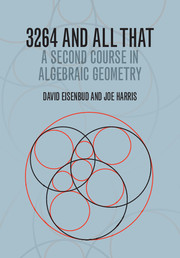Book contents
- Frontmatter
- Contents
- Preface
- Chapter 0 Introduction
- Chapter 1 Introducing the Chow ring
- Chapter 2 First examples
- Chapter 3 Introduction to Grassmannians and lines in ℙ3
- Chapter 4 Grassmannians in general
- Chapter 5 Chern classes
- Chapter 6 Lines on hypersurfaces
- Chapter 7 Singular elements of linear series
- Chapter 8 Compactifying parameter spaces
- Chapter 9 Projective bundles and their Chow rings
- Chapter 10 Segre classes and varieties of linear spaces
- Chapter 11 Contact problems
- Chapter 12 Porteous' formula
- Chapter 13 Excess intersections and the Chow ring of a blow-up
- Chapter 14 The Grothendieck Riemann–Roch theorem
- Appendix A The moving lemma
- Appendix B Direct images, cohomology and base change
- Appendix C Topology of algebraic varieties
- Appendix D Maps from curves to projective space
- References
- Index
Appendix B - Direct images, cohomology and base change
Published online by Cambridge University Press: 05 March 2016
- Frontmatter
- Contents
- Preface
- Chapter 0 Introduction
- Chapter 1 Introducing the Chow ring
- Chapter 2 First examples
- Chapter 3 Introduction to Grassmannians and lines in ℙ3
- Chapter 4 Grassmannians in general
- Chapter 5 Chern classes
- Chapter 6 Lines on hypersurfaces
- Chapter 7 Singular elements of linear series
- Chapter 8 Compactifying parameter spaces
- Chapter 9 Projective bundles and their Chow rings
- Chapter 10 Segre classes and varieties of linear spaces
- Chapter 11 Contact problems
- Chapter 12 Porteous' formula
- Chapter 13 Excess intersections and the Chow ring of a blow-up
- Chapter 14 The Grothendieck Riemann–Roch theorem
- Appendix A The moving lemma
- Appendix B Direct images, cohomology and base change
- Appendix C Topology of algebraic varieties
- Appendix D Maps from curves to projective space
- References
- Index
Summary
Can you define a bundle by its fibers?
To study the lines on a cubic surface back in Section 5.1, we needed to construct “the” vector bundle on the Grassmannian of lines in ℙ3 whose fiber at the point representing a line L is the space of cubic forms on L. This specification is at best incomplete: the condition determines only the rank of the bundle. In the example we needed an additional property: we wanted the restriction map from the space of cubic forms on ℙ3 to the line L to be induced by a map of bundles on the Grassmannian; that is, we needed the construction to be functorial in some reasonable sense.
To make things precise in this and many similar cases, we constructed the desired sheaves as direct images, and used the theorem on cohomology and base change to justify their properties. In this appendix we will give a gentle treatment of these important ideas. Much of the material is derived from Mumford [2008]; see also Arbarello et al. [1985, Chapter 4].
To state the problem more generally, suppose that we are given a family of varieties Xb with sheaves Fb on them, parametrized by the points b of a base variety B. As usual, by a family of varieties we mean a map π : X → B, the “members” of the family being the fibers Xb : π-1(b). Similarly, by a family of sheaves we mean a sheaf F on X, with the members of the family being the sheaves F|Xb. We can expect nice results only if the members of the family “belong” together in some reasonable sense, which we generally take to be the condition that F is flat over B. Given such data, we ask whether there is a functorial construction of a sheaf G on B whose fiber Gb at a point b is the space of global sections of Fb.
Such a sheaf G may or may not exist, as we shall soon see. Nevertheless, under very general circumstances we can define a sheaf π*F on B, called the direct image of F under π, […]
- Type
- Chapter
- Information
- 3264 and All ThatA Second Course in Algebraic Geometry, pp. 520 - 542Publisher: Cambridge University PressPrint publication year: 2016

